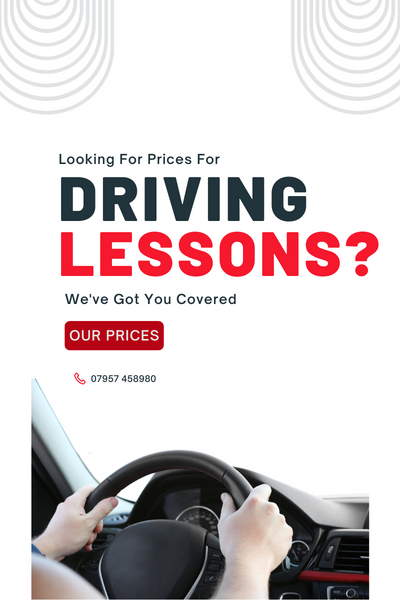Conquering Common Driving Fears
Learning to drive can be an exciting rite of passage, but for many new drivers it also brings intense anxieties. You may have vivid visions of all the things that could go wrong or feel your heart race when merging onto a busy motorway.
These driving fears are completely normal, especially when you’re still getting to grips with controlling a multi-ton vehicle hurtling down the road. Even experienced drivers can feel anxious in challenging situations like parallel parking or driving in poor weather.
The key is acknowledging your fears rather than feeling ashamed of them. Once you identify the specific roots of your driving anxiety, you can start to actively conquer them through practical techniques. Read on for tips tailored to some of the most common driving fears faced by new motorists.
Fear of Other Drivers
Let’s face it, other drivers can be unpredictable. Reckless lane changes, impatient tailgating, rude gestures – it’s enough to make anyone’s blood pressure skyrocket.
As a new driver, it’s natural to fear an encounter with an aggressive driver. Take comfort in the fact that these situations are rare, and your goal is to stay calm, avoid retaliation, and keep your eyes on the road.
If you fear other drivers are constantly annoyed by you, focus on driving courteously and with the flow of traffic. Learning defensive driving skills from your instructor will also help boost your confidence.
Fear of Losing Control
The thought of losing control of a fast-moving car is terrifying for new motorists. This fear can stem from not fully understanding your vehicle’s handling capabilities and technology like traction control and anti-lock brakes designed to prevent skids.
That’s why practicing vehicle control in safe environments like empty car parks is so important. Your instructor can walk you through techniques like hard stops, evasive steering, and regaining control in a skid.
Knowing how to handle your car on the edge gives you greater security behind the wheel day to day.
Fear of Breaking Down
There’s nothing more unnerving than picturing your vehicle grind to a halt on a busy carriageway. This fear is especially common for new drivers still getting acquainted with the workings of their car.
Prevention is key – make sure to diligently check fluid levels, tire pressure, lights etc. and have your car regularly serviced per the manufacturer’s schedule. Also, join a breakdown service like AA for peace of mind if issues do arise.
If you do break down, move to the hard shoulder, turn on hazard lights, and call for assistance right away. Your safety is the priority in this situation.
Fear of Getting Lost
In today’s GPS era, it may seem silly to fear getting lost while driving. But inputting the wrong location or misjudging turn lanes can still lead to disorientation, especially in unfamiliar areas.
Pinpoint your common trouble spots – do you struggle to merge across multiple lanes to make exits? Confuse east and west directions? Practice navigation skills like these repeatedly until they become second nature.
Always have a map or GPS as backup. But remember, stopping to reorient yourself is better than panicking and dangerous manoeuvres. If you miss a turn, stay calm and recalculate your route.
Fear of Driving Alone
After months of lessons, the prospect of driving solo for the first time can be daunting. Suddenly you don’t have the comfort of your instructor guiding you from the passenger seat.
Build up to independence gradually – first drive familiar routes alone in light traffic, then expand to new areas in busier conditions. Avoid situations beyond your capability until you’ve gained experience.
Practice self-talk and remind yourself of all the progress you’ve made. And just because you’re alone in the car doesn’t mean you’re ever stranded – pull over if needed and call someone for advice.
Relaxation Techniques for Calm Driving
Now that you’ve gained insight into some of the most common driving fears, let’s explore proven methods to ease anxiety behind the wheel:
Practice Deep Breathing
When we feel stressed, our breathing becomes rapid and shallow. Deep breathing signals your nervous system to relax. Take long, slow inhales through your nose, allowing your belly to expand. Slowly exhale through slightly pursed lips. Repeat for several minutes until your heart rate slows.
Listen to Soothing Music
Create playlists of your favourite calming music to play softly in the background when driving. Songs with slow, steady beats work best to bring down your heart rate and distract you from anxious thoughts. Avoid loud, energetic music that could overstimulate.
Visualize a Peaceful Place
When driving situations trigger your anxiety, visualise being in a beautiful, serene place like a beach, forest, or grassy field. Envision the details – sights, sounds, smells. Transporting your mind is an effective tool to interrupt anxious thought loops.
Talk Positively to Yourself
Squash negative self-talk that fuels fear. Counter anxious thoughts with empowering mantras like “I’ve practiced this and I know what to do,” “This car has safety features to help me,” “I will get more comfortable with each mile.”
Try Muscle Relaxation
Sitting tense and rigid negatively impacts your driving ability and mental state. Consciously relax your body – squeeze then release the tension in each muscle group starting with your toes and working up. Let your shoulders droop comfortably.
Avoid Caffeine
While it may seem counterintuitive, avoid caffeinated drinks before driving practice. Caffeine promotes the release of cortisol and adrenaline, increasing feelings of stress and nervousness. Opt for calming chamomile or peppermint tea.
Utilize Apps and GPS
Take advantage of apps like Pzizz and Be Focused Pro that guide you through relaxing music, meditation, and deep breathing while driving. Some GPS apps even have voice alerts to remind you to take deep breaths and calm down.
The Power of Practice for Driving Confidence
The more you drive, the more routine it becomes. Gradually exposing yourself to challenging driving scenarios in a safe practice setting helps desensitize you to the triggers of anxiety.
With regular practice, situations that once raised your heart rate – like busy roundabouts or night driving – start to feel familiar and manageable. You strengthen the muscle memory needed for tasks like reversing and parallel parking.
Make sure to practice under the supervision of your instructor in case fears feel fully overwhelming. But do challenge yourself to build skills as these key milestones approach:
- First motorway drive
- First rush hour drive
- First night drive
- First drive in rain/snow
- First drive alone
To maximize the benefits, focus practice on the specific situations you struggle with. Keep practicing them until you notice your skills and confidence growing. A driving diary can help track your progress.
The gentle approach of gradual exposure therapy rewires the brain’s response to triggers. Scenarios once coded as terrifying evolve into minor annoyances or non-events.
Support and Feedback from Instructors
A supportive instructor provides an invaluable boost to your self-assurance as a new driver. Ideally, you want to find an instructor who makes you feel completely at ease and provides specific, constructive feedback.
Knowing your instructor has years of experience dealing with anxious learners is comforting. They’ve seen it all and can gently coach you through difficulties, praising progress and keeping perspective.
During lessons, glean nuggets of wisdom from your instructor on topics like:
- Managing fears and lack of confidence
- Handling mistakes and stalls
- Multi-tasking and information overload
- Techniques for safe, defensive driving
Make sure to openly share your anxiety triggers with your instructor. They’ll tailor sessions to gradually build your capability and comfort.
Some instructors share inspiring success stories from past anxious learners who overcame their fears. This helps you visualise that you too can do it.
You want to exit lessons feeling capable and empowered, not defeated. So speak up if teaching methods don’t work for you. A supportive instructor wants to build your trust and confidence over time.
Driving Towards Your New Future
Learning to pilot a car for the first time is a major undertaking ripe with anxieties for many new drivers. But having awareness of common fears and practical tips to combat them puts you well down the road to success.
With time and practice, those once paralysing moments of panic start to dissolve. Self-doubt is replaced by growing inner confidence in your skills as a motorist.
Years from now, you may catch a glimpse of a nervous teen behind the wheel, bringing back memories of your own frazzled beginnings. You’ll smile with empathy, reflecting on the winding path to driving prowess awaiting them.




